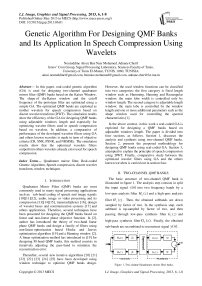Genetic Algorithm For Designing QMF Banks and Its Application In Speech Compression Using Wavelets
Автор: Noureddine Aloui, Ben Nasr Mohamed, Adnane Cherif
Журнал: International Journal of Image, Graphics and Signal Processing(IJIGSP) @ijigsp
Статья в выпуске: 6 vol.5, 2013 года.
Бесплатный доступ
In this paper, real-coded genetic algorithm (GA) is used for designing two-channel quadrature mirror filter (QMF) banks based on the Kaiser Window. The shape of the Kaiser window and the cutoff frequency of the prototype filter are optimized using a simple GA. The optimized QMF banks are exploited as mother wavelets for speech compression based on discret wavelet transform (DWT). The simulation results show the efficiency of the GA for designing QMF banks using adjustable windows length and especially for optimizing wavelet filters used in speech compression based on wavelets. In addition, a comparative of performance of the developed wavelets filters using GA and others known wavelets is made in term of objective criteria (CR, SNR, PSNR, and NRMSE). The simulation results show that the optimized wavelets filters outperform others wavelets already exist used for speech compression.
Quadrature mirror filter, Real-coded Genetic Algorithm, Speech compression, discret wavelet transform, window techniques
Короткий адрес: https://sciup.org/15012860
IDR: 15012860
Текст научной статьи Genetic Algorithm For Designing QMF Banks and Its Application In Speech Compression Using Wavelets
Published Online May 2013 in MECS DOI: 10.5815/ijigsp.2013.06.01
Quadrature Mirror Filter (QMF) banks are most commonly used in many signal processing applications such as: sub-band coding of speech and image signals [10][11][12], audio, image or video processing and its compression [13][14][15], transmultiplexer [16], design of wavelet bases and communication systems [17] and others applications. Therefore, several techniques have been presented for designing the QMF banks based on linear and non-linear phase objective function. In [2], author has introduced the theory of two-band linear phase QMF banks and design a family of filters using non-linear optimization based Hooke and Jeaves optimization algorithm [19] and a Hanning window [2]. A linear optimization method has introduced in [19] for designing M-band QMF banks, this method consists in iteratively adjusting the pass-band to minimize the reconstruction error.
Thereafter, several new iterative algorithms [20] [21] [22] [22] [23] [24] [25] have been developed using window technique to optimize QMF banks design.
However, the used window functions can be classified into two categories: the first category is fixed length window such as Hamming, Hanning and Rectangular window; the main lobe width is controlled only by window length. The second category is adjustable length window; the main lobe is controlled by the window length and one or more additional parameters such as the shape window used for controlling the spectral characteristics [1].
In the above context, in this work a real-coded GA is exploited for designing a QMF banks based on adjustable windows length. The paper is divided into four sections, as follows. Section 1, discusses the analysis and synthesis using two-channel QMF banks. Section 2, presents the proposed methodology for designing QMF banks using real-coded GA. Section 3, attempted to explain the principle of speech compression using DWT. Finally, comparative study between the optimized wavelet filters using GA and the others known wavelets is carried out in section four.
-
II. TWO-CHANNEL QMF BANKS
The basic structure of two-channel QMF bank is illustrated in figure 1. The analysis step consists in split the input signal x(n) into two frequency bands by a low-pass analysis filter H(z)and a high-pass analysis filter H(z). Then, the obtained subbands are down sampled by factor of two. In the synthesis step, each subband is up-sampled by factor of two, and then passing through low-pass synthesis filter G(z) and high-pass synthesis filter G(z). Finally, the obtained sub-bands are recombined to reconstruct signal y(n).
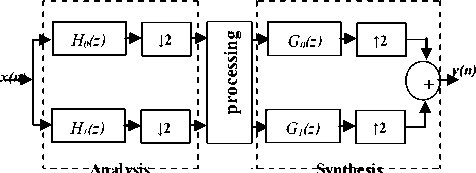
Figure 1. Two-channel Quadrature mirror filter banks.
The input output relationship of the two-channel QMF bank in the z-transform [9] is given in (1):
Y ( z ) = 1 [ H о ( z ) C o + H 1 ( z ) С , ] X ( z )
+ 2 E H o ( - z ) C o + H i ( — z ) С , ] X ( — z )
From the above equation, the reconstructed signal Y ( z ) composed by two terms each multiplied by the original signal X ( z ) . The first term, called the distortion transfer function, and the second term is the aliasing transfer function, which can be eliminated by the condition given in (2):
H , ( z ) = H 0( - z )
C o ( z ) = H 0( z ) (2)
C , ( z ) =- H 0( - z )
Then, the equation (1) becomes:
Y ( z ) = 1 [ H О ( z ) - H О ( - z ) ] X ( z ) (3)
From equation (3), it is clear that the complexity of the two-channel QMF bank design is reduced to design one only low-pass filter H ( z ). Now, Let H ( z )a finite impulse response filter (FIR) of even order N and a frequency response given in (2):
2 ® n
Ho(ej) = Ho(c)e 2(4)
The transfer function ( T ( e ' ” ) ) of the two-channel QMF bank using equation (3) becomes:
T (ej) = — {| Ho( ej )|2 +| Ho( —-'’)[}
The perfect reconstruction is possible if equation (6) is satisfied [2].
IH o( e■ )|‘+| Ho( —-")|' = 1
If the above condition is not satisfied, then a reconstruction error occurred. This error can be minimized by a simple real-coded genetic algorithm.
pass-band ripple ( 5 ) and stop-band ripple ( 5 ).
ps
Therefore, the filter based on Kaiser Window must be designed to meet the smaller of the 5 and 5 ps constraints:
5 = min ( 5 p , 5 s )
The Kaiser Window of length N is given in (8):
■ ( n )


I o ( в )
o < n < ( N — 1)
otherwise
Where Io ( . ) is a zero th order modified Bessel function of the first kind, which may be easily, generated using the power series expansion expressed as follow:
+^
I o ( - ) = 1 + ^
k = 1

The values of window shape (β) and window length (N) could be chosen to meet any set of design parameters ( 5 , ■ , ■ ):
ps
o.1,o2 ( A - 8.7 )
A > 50
в =
N =
0.4
o.5842 ( A - 21 )
+ o.o7886(A - 21) 21 < A < 5o
A - 8
2.285( " - ■ )
A < 21
Where, A = - 2o log10 ( 5 ) and ( " , ■ ) are
respectively the pass-band and stop-band transition.
The low-pass filter design with Kaiser Window will have a cutoff frequency ( ■ ) centered at [ " , ■ ]:
■
c
■p + "s
III. RREAL-CODED GA BASED ON QMF DESIGN
In this paper, different QMF banks are designed using a simple real-coded GA based on Kaiser Window. However, the Kaiser window depends on two parameters: the window length (N), and the shape window parameter (β) which controls the spectral characteristics of the window. Large values of β reduce the window side lobes and therefore result in reduced
In this case, the window parameters are completely determined. Now, the cutoff frequency ■ and the window shape (β) can be optimized such that the objective condition given in equation (6). In what follows, a simple real-coded GA is exploited in order to optimize the cutoff frequency ■ and the window shape (β).
Figure (2) illustrates the flowchart of the real-coded GA used for optimizing the cutoff frequency toc and the shape window (β) of Kaiser.
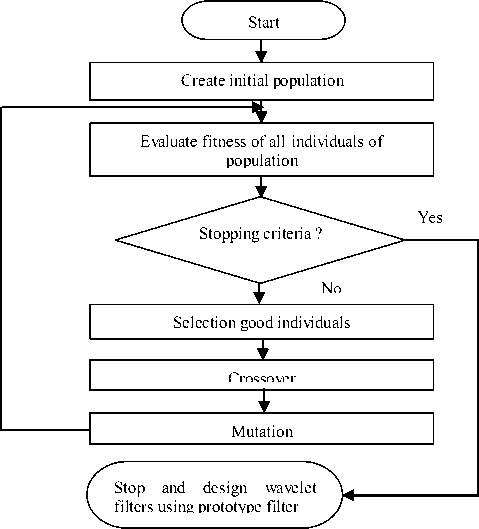
Figure 2. A flowchart of QMF banks design using GA.
-
3. GA stop if error is less than the tolerance ( err < tol ) or when the maximum number
iIi=1,2,...., n of generations is reached. Otherwise GA repeats the following steps.
o Selection good individuals : this operation consists in selecting individuals from the population for reproduction based on the relative fitness value of each individual. It can be performed by Elitist selection function: The best individuals of each generation are guaranteed to be selected.
o Crossover: to apply the crossover operator, two chromosomes are randomly selected from the population. Then the two chromosomes are chopped into two parts at the crossover point and they exchange their parts. For example :
Parent 1 = [ ^ в ] Parent 2 = [ ^2 Д ]
Children1 = [ ®,Д ] Children 2 = [ ^ 2 в ]
o Mutation randomly alters each gene with a small probability, typically less than 10%. This operator introduces innovation into the population and helps prevent premature convergence on a local maximum.
o Replace the current population with the new population.
The different steps of the adapted GA for designing wavelet filters are:
new population =
C[^ c 1
A ] . ^
[^ c 2 в 2 ] 2
1. Initialization of the population of chromosomes (set of randomly generated chromosomes).
l [ ^ cn e n ] n )
o Go to step 2.
-
4. Stop and design wavelet filter using prototype filter.
-
2. Evaluation of the fitness functions
Where, tod/1 = 1,2,..., n P i// = 1,2,..., n are respectively the initial values of the cutoff frequency and the Shape of Kaiser Window.
f ( to. , 6X. . o for each individual. j \ ci*> ri /Ii = 1,2,..., n
Design prototype filters using Kaiser Window (equation (8)) and compute the magnitude responses (MRC,„=,2):
MRCi ,„L2........= |e”'|«- = j(13)
err = Mr/ - MRC\(14)
iIi=1,2,....,n |i |
Where, MRI is the magnitude response in the ideal condition (MRI=0.707) [20] and erris iIi=1,2,...., n the fitness function.
-
IV. SPEECH COMPRESSION USING DWT
The Wavelet Transform (WT) has emerged as a powerful mathematical tool in signal processing area; it provides a compact representation of a signal in timefrequency domain. The Discrete Wavelet Transform (DWT) is a special case of the WT; it consists in decomposing a signal in too many functions by a function called a mother wavelet. The mother wavelet is dilated by powers of two and translated by integers. Specially, the signal x ( t ) in time domain can be expressed as follow:
X ( t ) = ^2 ^+1^ d ( j , k ) ^ (2 - j t - k ) j =1 k =—i
+ 22 a ( L , k )Ф (2 — L t — k )
k =-i (15)
Where, ^(t) and Ф(t) are respectively the mother wavelet function and the scaling function. a(L, k) is the approximation coefficients at scale L and d(j,k) is the detail coefficients at scale j . The approximation and detail coefficients are calculated using the following formulas:
L го
a ( L,k ) = 2 2 J x ( tф (2 - L t - k ) dt k,L ^X (16)
—^
j ^
d ( j , k ) = 2 2 J x(t ) ^ (2 jt - k ) dt j,k ^X (17)
—^
In [3], it was shown that the wavelets concentrate speech information (energy and perception) into a few neighboring coefficients. Therefore, after applying the DWT to the signal and the thresholding, many coefficients will be stetted zeros (have negligible magnitudes) and others retained. Compression is achieved by efficiently encoding the obtained coefficients.
The speech compression algorithm using wavelets can be divided in three major steps [3], [4], [5], [6], [7]: Applying the DWT to the original speech signal, thresholding the obtained coefficients and applying the inverse DWT to reconstruct the signal. More precisely the figure 3 illustrates the process of speech compression based on DWT, it is involves a number of different steps:
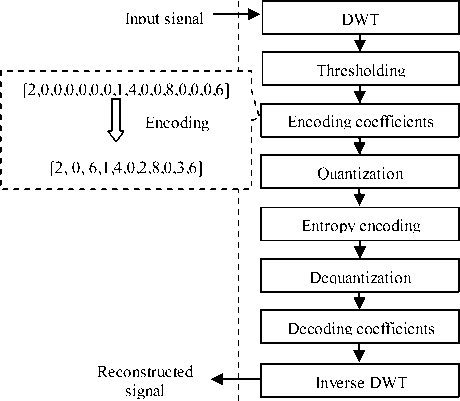
Figure 3. Principal block diagram of speech compression using DWT.
Step 1: Choosing the mother wavelet, the decomposition level and applying the discret DWT to the original speech signal. Here, the choice of wavelet mother is a very important step in speech compression based on wavelets. In [8], it was shown that the choice of an optimal mother wavelet depend on several different criteria, the main objective is to maximize the signal to noise ratio (SNR) and minimize the reconstructed error variance, the adequate decomposition level is up to scale five[8]. In this work, different mother wavelets filters are designed using the proposed algorithm. The choice of the optimal mother wavelet for speech compression is based on the CR, SNR, PSNR and RMSE.
Step 2: After applying the DWT, the obtained coefficients are thresholded. Generally, there are two ways to computing the threshold values; global thresholding and level depending thresholding. When the thresholds values are calculated, typically hard or soft thresholding can be applied to truncate the coefficients with negligible magnitudes. Then the obtained wavelet coefficients are encoded. In this paper, two byte are used to encode one or string values of zeros [3]: One byte to indicate the start of a sequence of zeros in the wavelet coefficients and the second byte representing the number of consecutive zeros (see example: figure 3).
The encoded coefficients are converted to others coefficients, with fewer possible discret values by a quantization algorithm such as: uniform, scalar or vector quantization algorithm. To remove the redundancy caused by the quantization, entropy encoding have been used such as: Huffman encoding or arithmetic encoding. The output bitstream of entropy encoding are multiplexed and transmitted.
Step 3: For reconstruct the speech signal, the received bitstream demultiplexed and entropy decoding is used to extract the quantized coefficients. Finally, an inverse quantization is applied to extract the encoded subbands followed by inverse DWT.
-
V. TESTS AND RESULTS
In this section, a MATLAB program has been written for implement the real-coded GA for QMF banks design described in this paper. The designed QMF banks are exploited as mother wavelets in speech compression algorithm based on DWT. In order to show the effectiveness of the optimized wavelets filters in speech compression, a comparative study of performance of the developed wavelets (see appendix) and others known mother wavelets (Daubechies and Symlet) is performed. The obtained results are calculated using the following formulas:
Signal to Noise Ratio (SNR): snr = ^ x ( n ) (18)
^1 x ( n ) - y ( n )|2
Peak Signal to Noise Ratio (PSNR):
PSR = 10log10

Normalized Root Mean Square Error (NRMSE):
I (x ( n ) — y ( n ))2 NRMSE = ( V
( x ( n ) - M x ( n ) )
Compression Ratio (CR):
CR =
size of original signal size of compressed signal
Where, x ( n ) and y ( n ) are respectively the original and the reconstructed speech signal, N is the length of the reconstructed speech signal and ^ ( n ) is the mean of the speech signal.
In the simulation, the optimal settings of the GA as follow in table 1:
TABLE 1. REAL-CODED GA PARAMETERS USED FOR QMF BANKS DESIGN.
|
parameters |
values |
|
Coding |
Real |
|
Population size |
40 |
|
Maximum number of generations |
30 |
|
Size of chromosome |
2 |
|
Cutoff ( to c ) |
0.45 - 0.60 |
|
Shape Kaiser window(β) |
4.54 - 8.96 |
|
Tolerance (tol) |
10-5 |
|
Fitness Function |
fitness =Minimize (|err-tol|) |
|
Selection Technique |
Elitist selection. |
|
Probability of selection |
0.5 |
|
Method of mutation |
Random. |
|
Mutation probability |
pmut = 0.1 |
|
Method of crossing |
One point crossover |
|
Probability of crossover |
pcross =0.5 |
|
Stopping criterion |
Maximum number of generations or fitness ≤tol |
TABLE 2. COMPARAISON OF PERFERMANCE USING DAUBECHIES AND SYMLET WAVELETS
|
Source waveform files |
Wavelet filters |
CR |
SNR |
PSNR |
NRMSE |
|
sx37.wav |
Kaiser8 |
5.2835 |
19.9408 |
38.7144 |
0.1007 |
|
Kaiser9 |
5.2491 |
20.0503 |
38.8240 |
0.0994 |
|
|
Kaiser10 |
5.2248 |
19.9233 |
38.6969 |
0.1009 |
|
|
Db8 |
5.0956 |
19.5683 |
38.3420 |
0.1051 |
|
|
Db9 |
5.0942 |
19.7040 |
38.4776 |
0.1035 |
|
|
Db10 |
5.0664 |
19.7664 |
38.5401 |
0.1027 |
|
|
Sym8 |
5.2597 |
19.7692 |
38.5428 |
0.1027 |
|
|
Sym9 |
5.1808 |
19.8227 |
38.5963 |
0.1021 |
|
|
Sym10 |
5.1912 |
19.8931 |
38.6668 |
0.1012 |
|
|
sx22.wav |
Kaiser8 |
4.4686 |
18.7862 |
36.3387 |
0.1150 |
|
Kaiser9 |
4.4366 |
18.9616 |
36.5141 |
0.1127 |
|
|
Kaiser10 |
4.3943 |
18.8450 |
36.3974 |
0.1142 |
|
|
Db8 |
4.3523 |
18.6474 |
36.1999 |
0.1169 |
|
|
Db9 |
4.2904 |
18.9032 |
36.4556 |
0.1135 |
|
|
Db10 |
4.3121 |
18.7913 |
36.3438 |
0.1149 |
|
|
Sym8 |
4.4223 |
18.6043 |
36.1568 |
0.1174 |
|
|
Sym9 |
4.4011 |
18.3853 |
35.9378 |
0.1204 |
|
|
Sym10 |
4.3562 |
18.7394 |
36.2919 |
0.1156 |
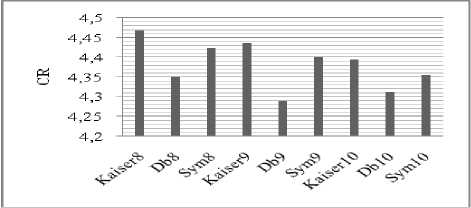
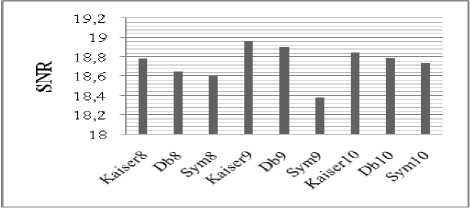
(a)
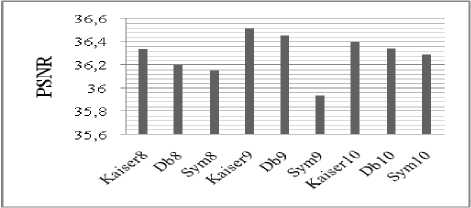
(b)
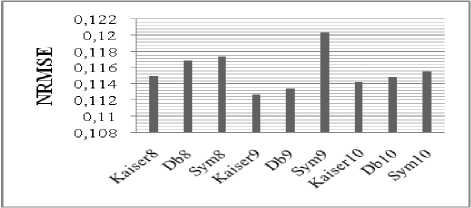
(c)
(d)
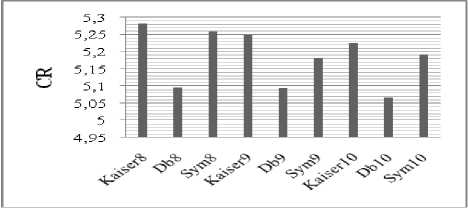
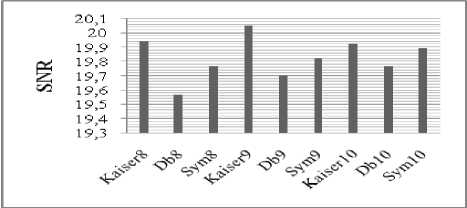
(e)
(f)

(g) (h)
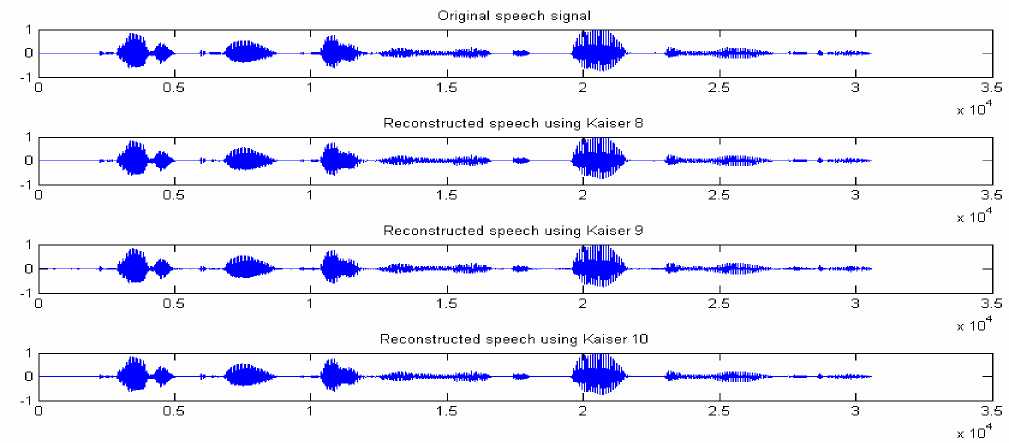
Figure 6. Original and reconstructed speech signal with different Kaiser Windows.
Figure 6 shows time domain representation of original speech signal (sx37.wav: “Critical equipment needs proper maintenance”) and its reconstructed versions using optimized wavelet filters: Kaiser 8, Kaiser 9 and Kaiser 10. It is clear that the reconstructed speech signals are similar to the original.
-
VI. CONLUSION
In this paper, a real-code genetic algorithm is used to design QMF banks based on Kaiser Window. The optimized filters as used as mother wavelets for speech compression based on discret wavelet transform. The spectral characteristics of the prototype filters are optimized to minimize the reconstruction error. The simulation results confirm the efficiency of the optimized wavelet filters on speech compression. From the comparative study of the developed wavelet filters and others known wavelets mother, it is also observed that the optimized wavelets using GA outperforms others wavelets already exist in term of CR, SNR, PSNR and NRMSE.
Список литературы Genetic Algorithm For Designing QMF Banks and Its Application In Speech Compression Using Wavelets
- A. Kumar, B. Kuldeep, "Design of M-channel cosine modulated filter bank using modified Exponential window", Journal of the Franklin Institute 349, 1304–1315, 2012.
- J. D. Johnston, "A filter family designed for use in quadrature mirror filter banks", In. Proceedings of IEEE International Conference Acoustics, Speech and Signal Processing, Denver, 291–294, 1980.
- W. Kinsner and A. Langi, "Speech and Image Signal Compression with Wavelets", IEEE Wescanex Conference Proceedings, IEEE, New York, NY, 1993, pp. 368-375.
- El-Bahlul F., PhillipsW. And Robertson W. 'Comparing audio compression using wavelets with other audio compression schemes', IEEE Canadian Conference on Electrical and Computer Engineering, pp.698-701, 1999.
- Noman J, Naveed A., Muktiar A. and A.Q.K Rajput "Speech and Image Compression Using Discrete Wavelet Transform", EEE/Sarnoff Symposium on Advances in Wired and Wireless Communication, pp. 45-48, 2005.
- G. Rajesh, A. Kumar and K. Ranjeet, "Speech Compression using Different Transform Technique", IEEE International Conference on Computer and Communication Technology(ICCCT), pp.146–151, 2011.
- Hatem Elaydi ("Speech compression using wavelets",http://site.iugaza.edu.ps/helaydi/files/2010/02/Elaydi.pdf.
- Johnson Ihyeh Agbinya, "Discrete wavelet transform techniques in speech process", IEEE, Australia, 1996.
- P. P. Vaidyanathan, "Quadrature Mirror Filter Banks, M-Band Extensions and Perfect-Reconstruction Techniques", IEEE ASSP, pp.4-20, July 1987.
- Heinrich W. Lollmann, Matthias Hildenbrand, Bernd Geiser, and Peter Vary, "IIR QMF-bank design for speech and audio subband coding", IEEE Workshop on Applications of Signal Processing to Audio and Acoustics, WASPAA '09. 2009.
- Kim, J.-K., "New linear phase QMF filter design for sub-band coding", IEEE Electronics Letters, pp.319–320, 1991.
- Zhongnong Jiang, Abeer Alwan and Alan N. Willson, Jr., "High-performance IIR QMF banks for speech subband coding", IEEE International Symposium on Circuits and Systems, ISCAS '94., pp. 493 - 496 , 1994
- Ying Deng, V. John Mathews, Behrouz Farhang-Boroujeny, "Low-Delay Nonuniform Pseudo-QMF Banks With Application to Speech Enhancement", IEEE Transactions on Signal Processing, pp. 2110-2120, 2007.
- Cvetko D. Mitrovski and Mitko B. Kostov, "NM images filtering using NPR QMF filters dependent on the images spectrum", 7th International Conference on Telecommunications in Modern Satellite, Cable and Broadcasting Services, pp. 119 – 122, 2005
- Cesar A. Gonzale, Ali N. Akansu, "A very efficient low-bit-rate subband image/video codec using shift-only PR-QMF and zero-zone linear quantizers", IEEE International Conference on Acoustics, Speech, and Signal Processing, ICASSP-97., pp. 2993 – 2996, 1997
- Ali N. Akanszl Xueming Lin Mehmet V. Tuzebay, "Spread Spectrum PR-QMF Transmultiplexer Codes for CDMA comminications", Proc. IEEE Digital Signal Processing Workshop, pp.109-112, 1996.
- Kenneth Hetling, Michael Medley Gary Saulnier, and P. Das, "A PR-QMF (wavelet) based spread spectrum communications system", IEEE Military Communications Conference, MILCOM '94. Conference Record, pp. 760 – 764, 1994.
- Charles D. Creusere and Sanjit K. Mitra, "A Simple Method for Designing High-Quality Prototype Filters for M-Band Pseudo QMF Banks", IEEE TRANSACTIONS ON SIGNAL PROCESSING, pp. 1005-1007, 1995
- R. Hooke and T. Jeaves, "Direct search solution of numerical and statistical problems," J. Ass. Comp. Mach., pp. 212-229, 1961.
- C. D. Creusere, and S. K. Mitra, "A simple method for designing high quality prototype filters for M-band pseudo QMF banks," IEEE Transactions on Signal Processing, vol. 43, pp. 1005-1007, 1995.
- A. Jain, R. Saxena, and S. C. Saxena, "A simple alias free QMF system with near perfect reconstruction", Journal of Indian Institute Science, 85, 1-10, 2005.
- A. Ramakrishna, Dr. M.J.Nigam, "A Simple Method to Design FIR QMF Banks", Fourth International Conference on Intelligent Sensing and Information Processing, ICISIP, pp. 236 – 239, 2006.
- A. Kumarn, B.Kuldeep, "Design of M-channel cosine modulated filter bank using modified Exponential window", Journal of the Franklin Institute 349, pp. 1304–1315, 2012.
- Ashutosh Datar, Alok Jain, P.C. Sharma, "Design of Kaiser window based optimized prototype filter for cosine modulated filter banks", Signal Processing 90, pp.1742–1749, 2010.
- J. Upendar, C.P. Gupta, G.K. Singh, “Design of two-channel quadrature mirror filter bank using particle swarm optimization”, Digital Signal Processing 20 , pp. 304–313, 2010.

